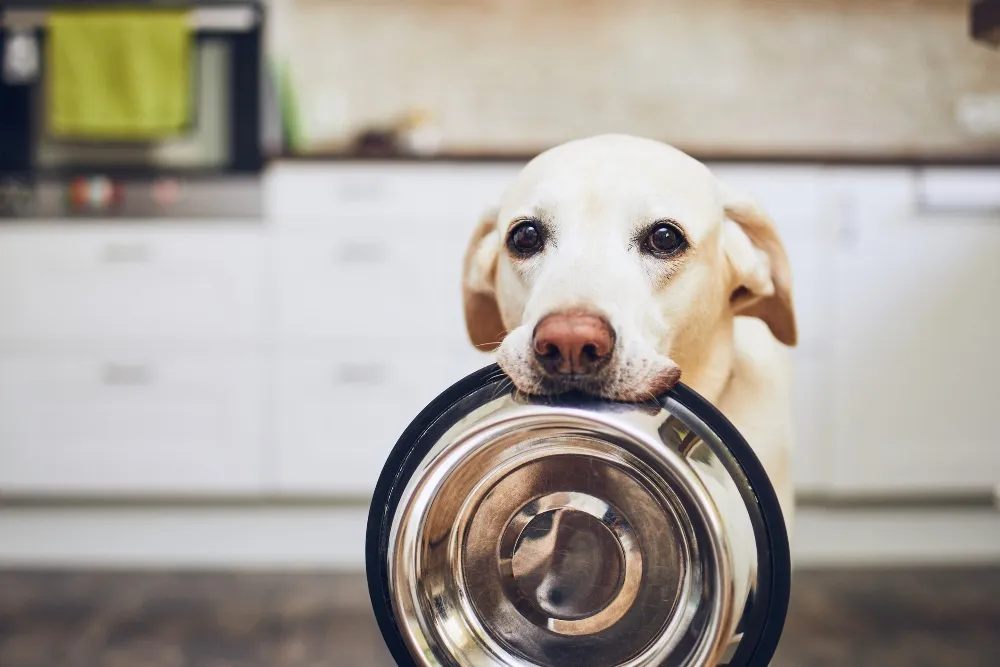Key Takeaways
- Should you run out of dog food, there’s a good chance you have the ingredients for an “in a pinch” meal or two for your dog.
- Know which foods are healthy for dogs and which ones to avoid before you assemble a meal.
- Human meals for dogs are not long-term solutions because they are not as nutritionally balanced or complete as commercial dog foods.
Table of Contents
It’s dinner time and your dog has made it clear that their food bowl is ready to be filled. Filled with what, though? With sinking dread, you realize that you are completely out of dog food. Now, your dog is looking at you with soulful eyes as if to say, “Seriously? You don’t have my food?”
As your mind races to figure out what to do, you decide that it’s time to get creative with the food that you have on hand. Chances are good that you have the ingredients for an “in a pinch” meal or two for your dog until you can purchase more regular dog food.
Keep reading to learn how to save the day for your dog’s tummy.
Foods to avoid
Before starting to rummage through your pantry or fridge, keep a few things in mind:
Avoid salty, spicy, sugary, or fatty foods
A dog’s palate is not exactly refined (remember that they eat poop!), so the meal that you prepare does not have to be a well-seasoned, culinary delight. In fact, anything other than plain foods could cause digestive upset, like vomiting, diarrhea, or constipation.
Avoid toxic and processed foods
Certain human foods, including grapes, raisins, onions, and garlic, are toxic to dogs. Processed foods like bacon and deli meats are off-limits because of their high sodium and fat content.
Meal considerations
Meat should be lean (at least 80% lean), cooked, skinless, and boneless
White meat chicken is ideal, but ground turkey or beef are also suitable. Boiling the meat is preferable to frying or grilling.
Consider your dog’s allergies and health conditions
Canine food allergies are commonly caused by meat-based proteins, like chicken and beef. Chronic health conditions like kidney or liver disease require a low-fat diet. As you think about what to prepare for your dog, consider a meal that won’t aggravate a food allergy or worsen a chronic disease.
This meal is only temporary
“In a pinch” human meals for dogs are not long-term solutions because they are not as nutritionally balanced or complete as commercial dog foods. The absolute longest that you want to feed these meals to your dog is a week—that should be more than enough time for you to buy more dog food.
Get cooking!
The meal that you prepare should be a good balance of lean protein and complex carbohydrates. Fortunately, you have a lot of foods in your pantry and fridge from which you can choose.
Pantry
- Peanut butter (xylitol-free)
- Plain, complex grains, like brown rice, couscous, and farina
- Low-sodium broth (vegetable, chicken, beef) for extra flavor
- Plain, unprocessed oatmeal (oatmeal packets are processed and sugary)
- Canned vegetables, such as corn, peas, and carrots: Rinse well and drain to remove sodium.
- Canned chicken in water: Rinse well and drain to remove sodium.
Refrigerator
- Plain, low-fat Greek yogurt
- Mild cheeses, such as American
- Cooked white or sweet potatoes
- Cooked eggs, such as scrambled eggs
- Rotisserie chicken, skin and bones removed
- Cooked lean meat, such as chicken, beef, or turkey
- Cooked or raw fresh vegetables, such as carrots, corn, and broccoli
- Fruits, such as blueberries, strawberries, and sliced bananas and pears
Remember that dogs aren’t picky eaters. Just make sure that the meal has a good nutritional balance of protein and carbohydrates. For example, a quick and easy meal is plain chicken served over plain brown rice in about a 50:50 mix. If your dog isn’t impressed, add a small amount of low-sodium broth to make the meal more appealing.
Another quick meal, particularly for breakfast, is 2-3 scrambled eggs over vegetables and a cooked grain. Add some fruit to give your dog something sweet to munch on.
You can also cook some ground beef and add that in with some cooked or raw vegetables and plain brown rice.
If you really want to have some fun, check out these recipes for more ideas on what to feed your dog in a pinch.
After the pinch is over
Now that you’ve solved the immediate problem of feeding your dog, you’ve given yourself some time to get more dog food. Once you’ve done that, it will be time to get your dog back to their regular diet. Not so fast, though—abrupt dietary changes can upset a dog’s tummy.
Transition your dog back to their regular diet gradually. Over several days, mix in increasing amounts of their regular dog food with the “in a pinch” food until your dog is eating only their regular food.
To avoid another food emergency, consider placing about a week’s worth of your dog’s regular food in a plastic baggie. Once the big bag of dog food is empty and you’re reaching for the baggie, it’s time to replenish your dog food supply. If you order your dog food online, choose the “auto-delivery” option so that you always have some extra dog food on hand.
Life gets busy, so it’s understandable if you run out of dog food occasionally. Surely, your dog won’t mind having some human food for a meal or two. Remember to keep those “in a pinch” meals healthy and get some regular dog food as soon as you can.
Want to make sure your pets are covered from those unexpected illnesses or injuries with no limits on payouts? Get a quote and make sure you’re covered for those dog and puppy mishaps and unpleasant surprises.








